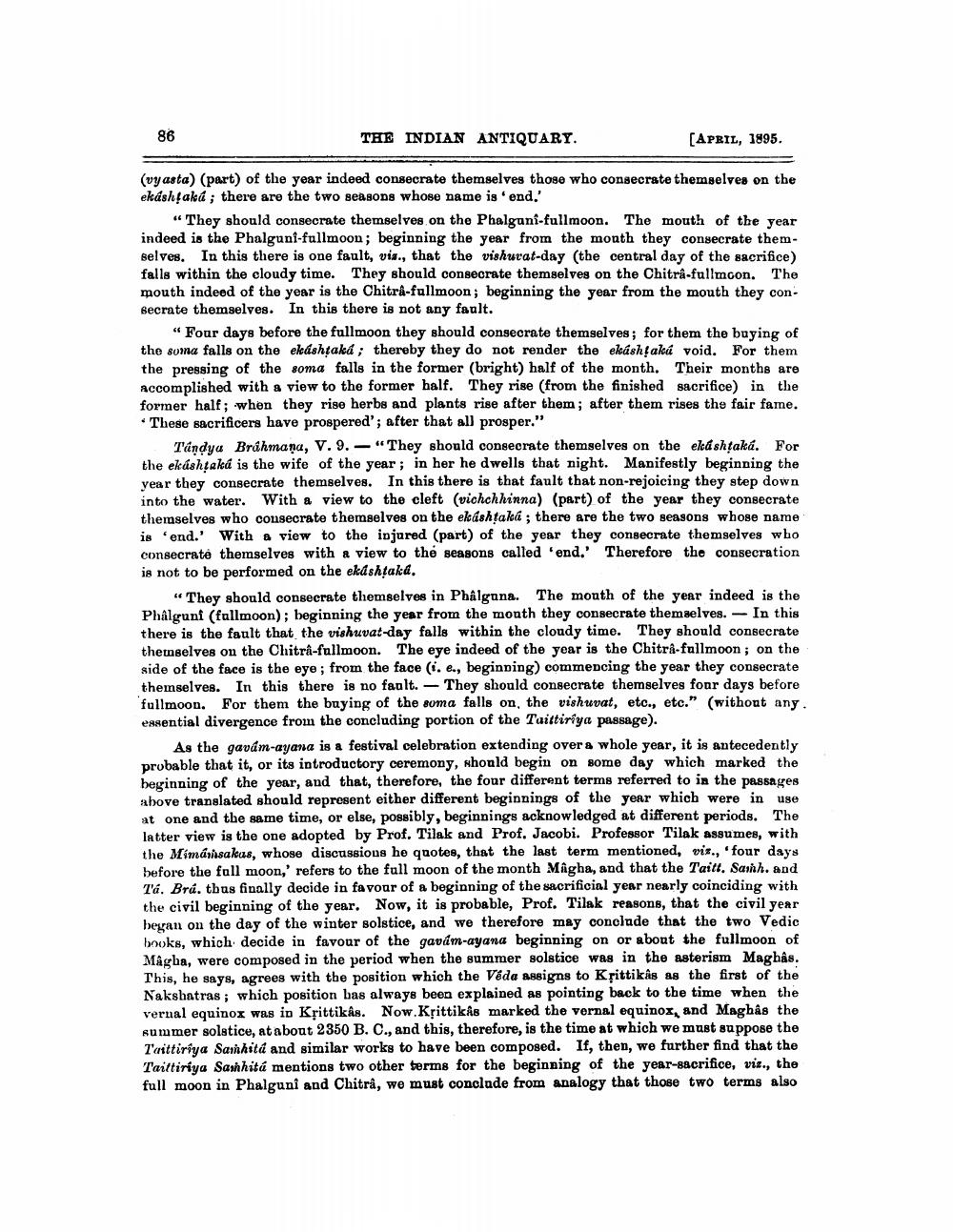________________
86
THE INDIAN ANTIQUARY.
[APRIL, 1895.
(vyasta) (part) of the year indeed consecrate themselves those who consecrate themselves on the ekáshtaka; there are the two seasons whose name is 'end.'
"They should consecrate themselves on the Phalguni-fullmoon. The mouth of the year indeed is the Phalguni-fullmoon; beginning the year from the month they consecrate themselves. In this there is one fault, vis., that the vishuvat-day (the central day of the sacrifice) falls within the cloudy time. They should consecrate themselves on the Chitra-fullmoon. The mouth indeed of the year is the Chitra-fullmoon; beginning the year from the mouth they consecrate themselves. In this there is not any fault.
"Four days before the fullmoon they should consecrate themselves; for them the buying of the soma falls on the ekáshṭaká; thereby they do not render the ekáshṭakú void. For them the pressing of the soma falls in the former (bright) half of the month. Their months are accomplished with a view to the former half. They rise (from the finished sacrifice) in the former half; when they rise herbs and plants rise after them; after them rises the fair fame. These sacrificers have prospered'; after that all prosper."
Tándya Brahmana, V. 9. "They should consecrate themselves on the ekáshṭaká. For the ekáshtaka is the wife of the year; in her he dwells that night. Manifestly beginning the year they consecrate themselves. In this there is that fault that non-rejoicing they step down into the water. With a view to the cleft (vichchhinna) (part) of the year they consecrate themselves who consecrate themselves on the ekáshṭaka; there are the two seasons whose name is end. With a view to the injured (part) of the year they consecrate themselves who consecrate themselves with a view to the seasons called 'end.' Therefore the consecration is not to be performed on the ekáshṭaka.
"They should consecrate themselves in Phâlguna. The mouth of the year indeed is the Phalguni (fullmoon); beginning the year from the month they consecrate themselves. In this there is the fault that the vishuvat-day falls within the cloudy time. They should consecrate themselves on the Chitra-fullmoon. The eye indeed of the year is the Chitra-fullmoon; on the side of the face is the eye; from the face (i. e., beginning) commencing the year they consecrate themselves. In this there is no fault. They should consecrate themselves four days before fullmoon. For them the buying of the soma falls on, the vishuvat, etc., etc." (without any. essential divergence from the concluding portion of the Taittiriya passage).
As the gavám-ayana is a festival celebration extending over a whole year, it is antecedently probable that it, or its introductory ceremony, should begin on some day which marked the beginning of the year, and that, therefore, the four different terms referred to in the passages above translated should represent either different beginnings of the year which were in use at one and the same time, or else, possibly, beginnings acknowledged at different periods. The latter view is the one adopted by Prof. Tilak and Prof. Jacobi. Professor Tilak assumes, with the Mimannsakas, whose discussions he quotes, that the last term mentioned, viz., 'four days before the full moon,' refers to the full moon of the month Magha, and that the Taitt, Samh. and Tá. Brá. thus finally decide in favour of a beginning of the sacrificial year nearly coinciding with the civil beginning of the year. Now, it is probable, Prof. Tilak reasons, that the civil year began on the day of the winter solstice, and we therefore may conclude that the two Vedic books, which decide in favour of the gavám-ayana beginning on or about the fullmoon of Magha, were composed in the period when the summer solstice was in the asterism Maghas. This, he says, agrees with the position which the Véda assigns to Krittikâs as the first of the Nakshatras; which position has always been explained as pointing back to the time when the vernal equinox was in Krittikâs. Now.Krittikâs marked the vernal equinox, and Maghâs the summer solstice, at about 2350 B. C., and this, therefore, is the time at which we must suppose the Taittiriya Samhita and similar works to have been composed. If, then, we further find that the Taittiriya Samhitú mentions two other terms for the beginning of the year-sacrifice, viz., the full moon in Phalguni and Chitrâ, we must conclude from analogy that those two terms also




